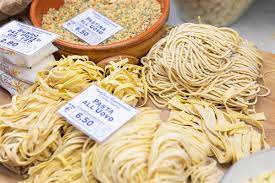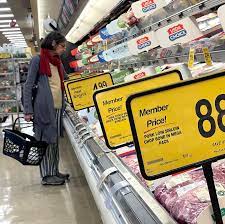Italy: Soaring pasta prices caused a crisis

Rome: A long-simmering issue finally boiled over last week, when Italy’s government convened crisis talks to address the skyrocketing price of pasta.
Pasta prices jumped 17.5% in March — more than double Italy’s inflation rate —compared to the same month in 2022, despite a drop in wheat prices. That was followed by a 16.5% year-over-year increase in April.
Out of Italy’s 110 provinces, people in only 12 of them could buy a kilogram (2.2 pounds) of pasta for less than $2.20, according to an April report from consumer rights group Assoutenti, cited by The Washington Post. It said some cities, like Modena, had seen a nearly 50% increase in pasta prices from last year.
Italy’s Industry Minister Adolfo Urso chaired a meeting with lawmakers, pasta producers and consumer rights groups in Rome on Thursday.
The commission said afterward that pasta prices were “already showing the first, albeit weak, signs of a [decrease], a sign that in the coming months, the cost of pasta will drop significantly.” And it promised to keep monitoring prices to protect consumers.
It may sound fusilli to some, but the pasta price hike is no laughing matter in Italy.

The average Italian consumed roughly 51 pounds of pasta last year, says David Ortega, a food economist and professor at Michigan State University.
“To say that pasta is a staple in Italy is an understatement,” he tells NPR over email. “It’s part of the cultural fabric of the country; their national identity. So, when pasta prices rise, especially of this magnitude, people notice, and it’s a big deal!”
But soaring food prices aren’t unique to Italy. In fact, Ortega says, federal data shows that the average price of spaghetti and macaroni actually rose even more in the U.S. this past year.
For starters, Americans eat much less of it, averaging just 19 pounds per person last year. And while the U.S. has been struggling with high food prices, those concerns and headlines tend to focus more on groceries in general.
“Unlike Italy which has a strong connection to pasta or Mexico, where corn tortillas are a key staple, the U.S. doesn’t have one defining staple food,” he writes. “We are a melting pot of various cultures and cuisines so there isn’t a singular food item or staple that really defines us. We just love food, so when the price of food goes up, as it has been, people feel it.”
While it may sound cheesy, there are lessons the rest of the world can learn from Italy’s pasta plight.
Some consumer advocates in Italy have accused pasta producers of raising prices to boost their profits.
Coldiretti, Italy’s biggest agricultural association, says the price of durum wheat — the main ingredient in Italian pasta — dropped by 30% since May 2022, arguing there is “little justification” for the spike in retail prices.
Companies blame inflation and supply chain issues for driving up production costs. A spokesperson for Unione Italiana Food, which represents food producers, told CNN that retail prices are influenced by the rising costs of energy, packaging and logistics.
There’s no single culprit behind high pasta prices, according to Michigan State University’s Ortega. He points to a combination of factors, including lingering supply chain disruptions from the COVID pandemic and Russia’s war in Ukraine.
“Add to this the effects of climate change, bird flu, and changes in consumer behavior and you have the perfect storm of factors that are leading to high rates of food price increases, including the price of pasta,” he says.
Indeed, global prices for food commodities like grain and vegetable oils set new records in 2022, according to the U.N.
Ortega notes that the actual ingredients in the pasta on supermarket shelves represent “a fraction of the overall costs.” And while wheat prices are down from their highs last summer, it takes time for those lower costs to make their way down the supply chain and onto price stickers.
“Food prices tend to be sticky — they rise quickly but tend to take longer to come down,” he says.
Pasta isn’t the only grocery staple getting more expensive in Italy, not to mention other parts of the world.
Ortega notes that food prices in Italy rose 12.1% in April compared to the previous year. In contrast, he says, the country’s average rate of food price inflation for the five years before COVID-19 was about 2%.
Many countries in Europe have being seeing double-digit increases in food prices for several months, Ortega says, which has also been the case in the U.S. in recent years.
And while food prices have started to drop, they’re still 7.7% higher than they were a year ago, according to April data from the Bureau of Labor Statistics.
Pasta wasn’t immune from inflation: Ortega says the price of spaghetti and macaroni in the U.S. rose by nearly 20% in April compared to the same month last year, from $1.22 to $1.46 per pound.
But that didn’t cause nearly as big of a stir as the surge in egg prices earlier this year, which was due mainly to a widespread bird flu outbreak.
Egg prices jumped monthly beginning in the fall, with the average price of a dozen Grade A eggs soaring from $2.90 in September to $4.82 at its peak in January.
Ortega says he’s now keeping his eye on the price of cereals and bakery products, since there have been “significant increases in that category for a while now.” U.S. Bureau of Labor Statistics data from April shows that those products are up 12.4% from the same time a year ago.
He’s hopeful that the rate of price increases will start to slow down, though there’s one sizeable caveat.
“There are signs that inflationary pressures are starting to abate,” Ortega says. “But this doesn’t necessarily mean that these food items are getting cheaper, just that the price increases are starting to moderate.”





